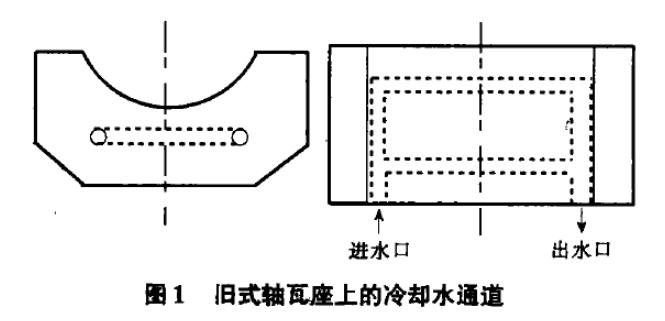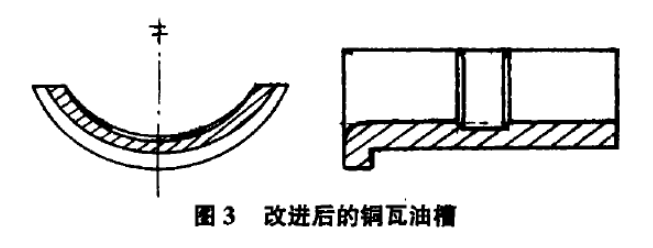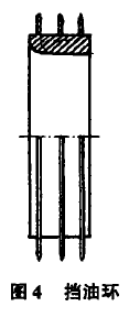
Abstract: Through the transformation of the copper tile bearing and bearing seat of the old two-high aluminum plate mill and the use of the new type FC series rolling bearing, the bearing heat of the mill is reduced, the stability of the machine is improved, and the production efficiency of the mill and the rolling degree of aluminum plate are improved.
Key words: bearing; Heat; Improvement; efficiency
With the marketization and competition of the economy, some new enterprises have purchased the old rolling mill of the bankrupt enterprise, and then through certain technical transformation, it has become a new performance aluminum plate rolling mill.
In the renovation design of rolling mill, in addition to the major design problems caused by rolling force, such as drag force, roll speed, mechanical strength and stiffness will affect the performance of the rolling mill, the bearing selection of the rolling mill, the structural type and machining tolerance of the bearing and bearing seat, the cooling and lubrication method, the local climate conditions, all have a great impact on the heating and service life of the rolling mill bearings. In particular, the heating of the bearing will have adverse consequences on the thickness and accuracy of the rolled aluminum plate, making the thickness and rolling tolerance of the aluminum plate difficult to control, the following two examples of bearing transformation.
1 Improvement of copper bearing of rolling mill
Copper tile bearings generally cannot be made too large and too long, otherwise, although the pressure per unit area of copper tile is reduced, the heat in the middle part of the copper tile is not easy to be dissipated, the accumulation of heat will cause the journal and copper tile to overheat, overheated journal and copper tile will make the cooling lubricant cannot enter between the journal and copper tile, to reduce friction and take away heat. Even a large injection of coolant lubricant does not help. In this way, heat and wear enter a vicious cycle, resulting in rapid wear failure of the journal and copper tile. In this regard, the method adopted by the author is to shorten the heat transfer path as much as possible, if the heating problem is solved, the lubrication liquid can be smoothly into the human journal and the copper tile, the friction between them will be reduced, and the heat will be reduced. The author has made three changes to the bearing bush and the bearing seat.
(1) Improvement of cooling water channel of bearing bush seat
The cooling water channel on the bearing bush seat of the original milk machine is "well" shaped, as shown by the dotted line in Figure 1. This "well" shaped water channel is far away from the copper tile, about 50mm, the channel is rare, and each channel bears a large heat absorption area. In addition, there are two water channels in the bearing bush seat, one is longer and one is shorter. Obviously, longer water channels will have stagnant water phenomenon, and the water will slowly become hot.

Now change the cooling water channel to a "zigzag" water channel very close to the copper tile placement, as shown in Figure 2, each channel bears a relatively small heat absorption area, the distance between the two copper tiles and the channel is very short, less than 10mm, the heat on the copper tile can be quickly transferred to the water in the channel and taken away by the water, and will not be as "well" -shaped water channel as the flow problem. The endothermic cooling effect is very good.

(2) Improvement of oil groove on copper tile
The original copper tile is a large, thick and long curved bearing tile, tile has an X-shaped oil groove inside the surface, because the oil groove is narrow and shallow, the amount of oil storage is small, the heat generated in the middle of the bearing is difficult to conduct out the thickness of the copper tile after the transformation is reduced to about 15mm, so that the heat in the copper tile to shorten the distance of the tile back. In addition, an oil groove 50mm wide and 3mm deep is processed in the middle part of the copper tile for lubrication and heat dissipation, as shown in Figure 3.

There is no heating area in the center of the copper tile, and more cooling sea slime can be injected into the oil tank to take away the heat generated on both sides of the oil tank in the middle of the copper tile, and the heat at both ends of the copper tile is taken away by the air, and the heat transmission path on the copper tile is very short. The cooling lubrication liquid in the oil tank will flow from the middle of the copper tile through the gap between the journal and the copper tile to the two ends of the copper tile, which lubricates the journal and the copper tile well, reduces the heat generated by friction, and also takes away part of the heat generated by friction. The effect of this copper tile is very good, after a month of use, a thin, uniform black oil film appears on the inner arc of the copper tile and the journal, and the journal and the copper tile run in an approximate non-wear state.
(3) Install oil baffle device
Because the copper tile requires a large flow of cooling lubrication fluid, in the long-term operation, the cooling lubrication fluid will flow from the journal to the two ends of the roll working surface, absorbed by the wool felt oil cloth, and gradually moved to the middle part of the roll working surface through the wool felt, resulting in a full roll of cooling lubrication fluid. When rolling the plate, the cooling lubricant will contaminate the surface of the aluminum plate and make the surface of the aluminum plate lose luster. Yellow marks are left on the surface of aluminum sheet when annealed. In order to solve the problem of cooling lubricant climbing on the roll surface, we install an oil baffle ring as shown in Figure 4 on the shaft journal near the end of the roll surface. After installing this device, the cooling lubricant will no longer climb on the roll surface by the shaft journal to ensure that the aluminum plate is not polluted by it.

2 Use design of rolling bearing in the board hoisting machine
Rolling bearings are selected for rolling mill bearings, which can reduce friction energy consumption, reduce journal wear and heat, reduce maintenance costs, improve the accuracy of aluminum plate and reduce the tolerance of aluminum plate.
FC series bearings are more suitable for aluminum plate rolling mill, this type of bearing bearing capacity is large, stable performance, easy to install and debug, bearing is not easy to damage.
In the design of rolling bearings, the match between the journal and the bearing inner ring is a static match, and the tolerance of the journal is p6, so that the bearing inner ring will tightly hoop the journal and rotate with the rotation of the roll, and the force point on the inner ring is often changed, so that the inner ring is not easy to deform, and it is difficult to damage the match between the bearing seat hole and the bearing housing is a dynamic match, and the tolerance of the bearing seat hole is G7. In this way, when the shell is stressed, it will move slowly with the rotation of the roll, so as to constantly change the stress point, avoiding the problem that the shell is stressed in a position for a long time and easy to damage.
FC series bearings are four row cylindrical roller bearings, which have no axial positioning structure. Two axial thrust rings need to be installed on each roll to prevent the rolling roller from moving. The thrust ring can be a friction thrust ring or a rolling thrust ring.
The friction thrust ring is equipped with a wear-resistant ring part as shown in Figure 5 at the inner corner of the journal. The big end of the thrust ring is aligned with the end face of the roll working surface, and the small end is used to locate the installation position of the bearing inner ring. The inner corner of the thrust ring hole is matched with the inner corner of the journal, and the outer corner of the thrust ring is matched with the inner corner of the bearing seat cover, which is connected by the side pressure plate tube. In this way, both ends of the roll use this device, and the roll will not move axially. The disadvantage is that the wear resistance of the thrust ring material is poor, and the thrust ring is easy to wear when the processing accuracy and roughness are low.

The rolling thrust ring is improved to overcome the shortcomings of the friction thrust ring by adding a thrust ball device between the original thrust ring and the end cap, the shape of which is shown in Figure 6. Replace the original friction thrust ring with a thrust washer in the shape of Figure 7, which turns sliding thrust into rolling thrust, reducing resistance and wear, extending the service time of parts, and reducing maintenance costs.
If it is processed in the summer with higher temperatures, and when assembling in the winter with lower temperatures, the tolerance of the inner hole of the bearing seat should be appropriately increased, because the material expansion coefficient of the bearing seat is larger, and the material expansion coefficient of the bearing housing is smaller, if it is still selected according to the tolerance of G7, it is likely to be unable to be installed. The expansion coefficient is large, it will expand a lot in summer, and it will shrink a lot in winter. When assembling in winter, the assembly requirements that are laborious and do not meet the pressure of the roller bearing housing are also moved will artificially shorten the service life of the bearing.
3 Use condition after transformation
(1) The use of copper tile bearings
When the copper tile bearing rolled the plate for the first time, the temperature reached about 70℃, but as long as the mill was idled for 2-3min without feeding the plate, the temperature of the copper tile returned to room temperature. This is mainly due to the rough manufacturing of the bearing bush, and the tolerance and roughness do not meet the requirements of the drawing. Even if the processing meets the requirements of the drawing, there is also a problem in the running-in period, the temperature is definitely higher during the running-in period, after the use of a shift, the temperature of the copper tile is reduced to 40-50℃, after a month of use, there is a thin uniform layer of black oil film on the journal, completely can not see the original material of the journal, the temperature on the copper layer is slightly higher than room temperature. In this condition, as long as there is no lack of cooling lubricant on the journal, the copper tile and the journal almost work in a non-wear state, and no heat is uploaded to the working face of the roll at both ends of the journal. As long as the gap between the two rolls is adjusted, the thickness of the rolled plate will not change.
(2) The use of rolling bearings
After the installation of the rolling bearing, the situation is normal for more than a month after the start of use, and more than a month later, it was found that one of the bearing seats was a little hot, and the inspection found that the reason for the heat was the fracture of the bearing inner ring. It was found in the initial installation that the tolerance of the journal was less than p6, and it could be fitted to the journal without heating, and the bearing installed on the journal with this tolerance was easy to break its inner ring. Therefore, when processing rolls, the tolerance of the shaft diameter must meet the requirements. The control of the thickness of the aluminum plate is also very stable, and the thickness of the aluminum plate produced on this mill is 0.30mm.
4 Summary of rolling mill bearing design
(1) Copper tile bearing mill
The pressure on the unit area of the copper tile should be as small as possible, preferably about 30% less than the allowable pressure of the copper tile material used.
To shorten the heat conduction path as much as possible, the length of each conduction path is preferably not more than 35mm.
There should be sufficient coolant and lubricating fluid (grease) supply to the bearing and bearing seat without interruption.
(2) Rolling bearing mill
The match between the journal and the bearing inner ring must be a static match, and the tolerance of the journal is selected around p6.
The match between the bearing seat and the bearing outer ring must be a transitional match, and the tolerance of the bearing seat hole should be around G7.
It is necessary to have a reliable axial positioning thrust device to prevent the axial movement of the roll.
It is necessary to select a reasonable bearing and roll neck fitting tolerance according to the climate change.